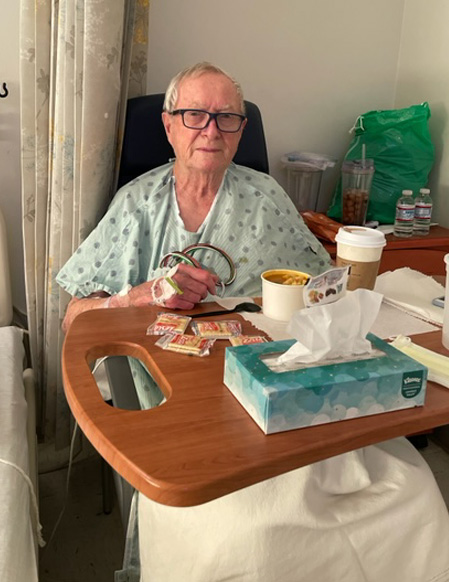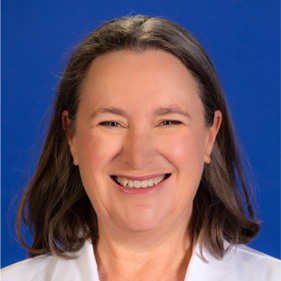Uc Davis Health System Art in the Emergency Room
(SACRAMENTO)
This past Jan, 91-yr-one-time Art Foster began fighting a "cold that seemed similar it wouldn't stop." After a telehealth visit, his doctor recommended he quickly get to the emergency department (ED).
"It turns out he had an infection throughout his entire body," recalled his girl, Alison Gomez, who drove him toUC Davis Medical Centerfrom his home that day.
Foster's condition turned life threatening. Later asking Gomez and her sister about their father's wishes, the care team jumped into action.
"I was lucky to survive," Foster said.
Circuitous conditions crave coordinated approach
UC Davis Medical Centrehas achieved national recognition for its ability to provide quality treat patients like Foster. On April 4, theAmerican College of Emergency Physicians(ACEP) awardedGeriatric Emergency Department Accreditation— Gold Level 1, the highest level of accreditation — to the geriatric ED. UC Davis Health is the only ED in Sacramento to earn this accreditation and joins only 21 other EDs in the nation that have achieved gold status.
"While our older patients may show upwards because of injuries sustained by a autumn or complications from congestive center failure, our treatment goes beyond that acute situation," explainedKatren Tyler, the physician who oversees the Historic period Friendly Emergency Department and a leader of UC Davis Health's healthy aging work. "We must evaluate conditions that are more common as we become older, addressing underlying conditions and ensuring safe transitions, be it inpatient or outpatient in a community setting."

More than than 19,000 people over the age of 65 visit UC Davis Wellness's ED each year. And while their younger counterparts frequently utilise the ED for sometime crises, older adults oft arrive with complex underlying conditions.
Authors ofa major studythat details the increase in geriatric emergency rooms fence that conventional EDs may not adequately address older patients' unique needs. Since EDs lie at the crossroads of inpatient and outpatient care, they can be game changers in the health and well-existence of older adults when designed specifically with them in mind.
That's why Tyler led the ACEP endeavour, which provides a standardized set up of guidelines to meliorate the intendance of older adults.
To earn accreditation, the multidisciplinary team of emergency physicians, geriatric nurse specialists, pharmacists and others must follow specific protocols that:
- Ensure focused education and interdisciplinary staffing for the care of older adults
- Provide standardized approaches to care that address common issues for older people
- Ensure optimal transitions of care from the ED to other settings (inpatient, domicile, community-based intendance, rehabilitation, long-term care)
- Promote quality improvement workflows for the care of older adults and enhancements of the physical environment and supplies
"We know that one size does not fit all when it comes older adults in the ED," Tyler said. "Evaluating whether an older person requires a stay in the hospital can be complicated. Arranging effective outpatient care is critical since astute events tin can be followed by substantial functional decline, including the need for increased support at abode or in a skilled nursing facility."
Continued commitment to older adults
Last twelvemonth, the ED was named an Age-Friendly Health Systems Committed to Care Excellence for itsage-friendly arroyo. That initiative of The John A. Hartford Foundation and the Institute for Healthcare Improvement (IHI)considers older adults' 4 Grand's: their medication, mentation (cerebral state), mobility and what matters to them. UC Davis Health's Geriatric ED Accreditation program has also focused closely on the 4Ms.
These designations are goals for theHealthy Aging Initiative, a formal, coordinated try designed to create an integrated arroyo to older adults across the lifespan and all care settings at UC Davis Health. Providers like Tyler are committed to age-friendly intendance and services that increment admission to health intendance, better quality of life and subtract the complexities of navigating the wellness care system.
We know that one size does not fit all when it comes older adults in the ED. — Katren Tyler, physician lead for the Age Friendly Emergency Department

More dinners, trips to the theater
Ultimately, the approach aims to decrease hospital admissions and future ED visits, as well every bit hospital readmissions 30 days after the initial visit. But for patients like Foster, the focused attention, geriatric-tailored expertise and care that aligns with his wishes mean he can go on enjoying family dinners and alive theater performances.
"I'm pretty stubborn with what I'll do and won't practice. Just I felt with these doctors information technology was a conversation. They didn't dictate," he said.
"I felt like what UC Davis understands is the pacing," Gomez explained. "With older people they demand more time to process, they demand more time to heal. They don't need stress or to rush."
Now Foster works on goals he developed with his care team. And he has tickets to see Irish musical group 'Celtic Adult female' in May, together with his family unit.
"It'south a good system," he said.
Source: https://health.ucdavis.edu/news/headlines/emergency-department-earns-accreditation-for-its-care-of-older-adults/2022/04
0 Response to "Uc Davis Health System Art in the Emergency Room"
Post a Comment